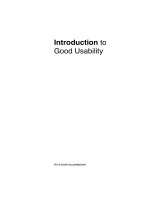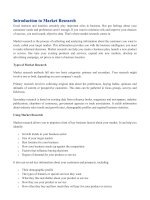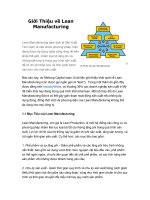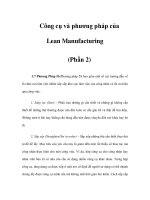Introduction to lean manufacturing TPM1
Bạn đang xem bản rút gọn của tài liệu. Xem và tải ngay bản đầy đủ của tài liệu tại đây (5.37 MB, 42 trang )
Lorraine Fraser, P.Eng., M.Eng., MBA, CQE, CQA, CQM/OE, CSSBB
ASQ Toronto Section – November 11, 2015
Introduction
To TPM
Benefits of TPM
What does TPM look like?
How to implement TPM
How to Sustain TPM
Summary
Questions
TPM
The 7 Wastes
TPM
TPM stands for Total Productive Maintenance.
TPM Development was first published in Japan in 1982. Since then new
concepts and refinements have been added to the basic program.
TPM first took root in the automotive industry. More recently it has been
introduced in consumer goods, electronics, plastics and many others.
Administrative and support departments such as product development
and sales also use TPM.
Production output and rate, quality, safety, and the environment depend
almost entirely on the state of equipment.
TPM is a method for continuously improving the effectiveness of
production equipment and processes.
TPM
World Class Operating Excellence is Achieved using optimized work standards with
group activities of associates who demonstrate ownership
Office
People
Logistics
Early Equipment
Management
Training & Development
Productivity
Quality Management
Cost
Environment, Health &
Safety
Planned Maintenance
Quality
Autonomous Maintenance
Improvement
Focused
Safety
5S & Teams
TPM
Guarantees Significant Tangible Results - Results achieved include –
reduction in equipment breakdowns, lower quality defects and claims,
higher productivity, shrinking inventory, lower number of accidents.
P… net productivity up by 2x
Q…process defect rate down 90%
C…production costs down 30%
D…production and work in process inventories halved
S…accidents 0
M…improvement suggestions up by 10x
Transforms the Plant Environment – a rusty plant can be reborn as a
pleasant, safe working environment.
Transforms the Employees - As concrete results are achieved, workers
become motivated. Associates begin to think of TPM as part of their
job.
TPM
Benefits of TPM
Customers and visitors are impressed by these changes
Confidence in the plant’s products increases.
Overall Equipment Effectiveness (OEE) is maximized through
zero breakdowns and failures, zero accidents, zero defects
through total employee involvement.
Equipment reliability and maintainability as contributors to
quality and productivity is increased.
TPM culture promotes zero loss activities.
TPM involves all associates from the shop floor to top
management.
TPM
Benefits of TPM
TPM
TPM
What Does TPM Look Like?
Machine Operators are trained to do much of the maintenance
operations, and it’s part of their Standard Work
TPM
What Does TPM Look Like?
Necessary tools are readily available
TPM
What Does TPM Look Like?
Equipment is modified such that it easy to keep clean, easy
to see when maintenance is required.
Befor
e
After
TPM
What Does TPM Look Like?
Happy and Engaged Associates……
TPM
How To Implement TPM?
1. Formally announce decision to introduce TPM.
2. Conduct TPM introductory education & publicity campaign
3. Create a TPM promotion organization.
Plant Manager
Companywide TPM promotion
Committee
Section Managers
Plant TPM Promotion
Committee
Group Leaders
Section TPM Promotion
Committee
Shop Floor Associates
PM circles
TPM
How To Implement TPM?
4. Establish basic TPM policy and goals.
Policy – example:
Establish a profitable corporate constitution, promote TPM
Establish numerical goals – examples:
Zero breakdowns,
Zero defects, seek to maximize overall equipment effectiveness.
TPM
How To Implement TPM?
5. Draft a master plan for implementing TPM.
To formulate a master plan for implementation decide what
activities must be pursued to achieve the TPM goals.
The core TPM activities are:
Focused improvement
Autonomous Maintenance
Planned Maintenance
Education and Training
Early Equipment Management
Quality Maintenance
Administrative and support department activities (Logistics & Office)
6.Kick off TPM initiative – should be designed to cultivate an atmosphere
that raises morale and inspires dedication.
TPM
How To Implement TPM?
7. Build a corporate constitution designed to maximize production
effectiveness.
8. Build an early management system for new products and
equipment.
9. Build a quality maintenance system.
10. Build an effective administration and support system.
11. Develop a system for managing health, safety, and the
environment.
12. Sustain full TPM implementation and sustain levels.
The first pillars to implement are the Focused Improvement, Autonomous
Maintenance, Planned Maintenance, & Training and Development
Pillars
TPM
How To Implement TPM?
TPM
How To Implement TPM?
The Eight Major Plant Losses:
Shutdown loss
Production adjustment loss
Equipment failure loss
Process failure loss
Normal production loss
Abnormal production loss
Quality defect loss
Loss deployment
◦ All pillars are responsible
for analyzing the loss
deployments for their
losses.
◦ As losses are reduced,
the priority of teams
selected will change
Reprocessing loss
TPM
How To Implement TPM?
TPM
How To Implement TPM?
TPM
How To Implement TPM?
TPM









